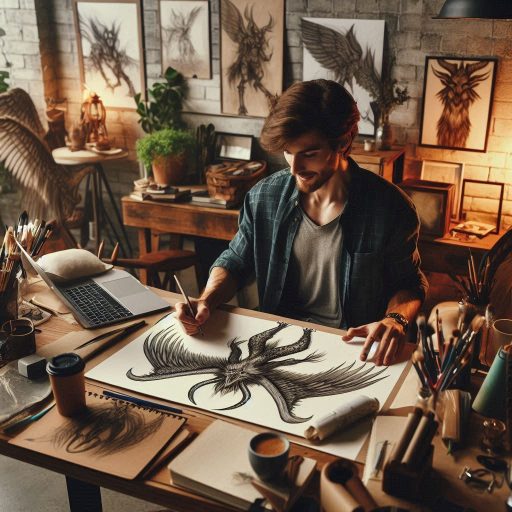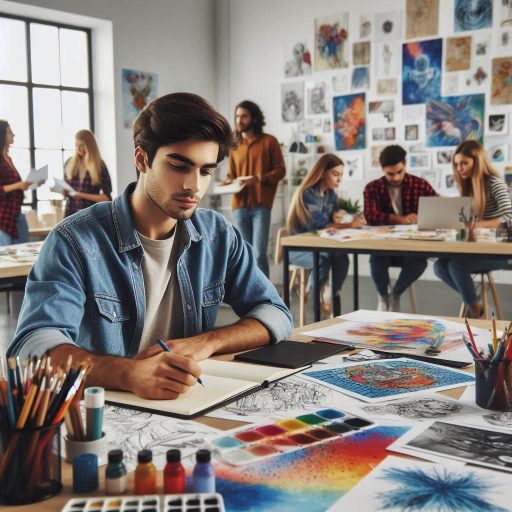Introduction
Concept art is a foundational element in creative industries like film, gaming, animation, and advertising.
It involves visualizing characters, environments, objects, and entire worlds before they are fully developed.
Ensuring that design and storytelling align with a project’s creative vision.
Concept art is often the first step in the pre-production phase.
Where artists work closely with directors, game designers, and animators to shape the look and feel of a project.
It helps establish tone, mood, and overall aesthetics, providing a blueprint for the production team to follow.
In this rapidly evolving field, concept art blogs and communities play a vital role in an artist’s development and career growth.
These platforms offer a wealth of resources, including tutorials, interviews with industry professionals, and showcases of emerging trends.
They serve as educational tools for aspiring artists, offering insights into new software, techniques, and industry standards.
Engage with concept art blogs and communities to access the latest tools and techniques.
Stay relevant and adaptable by continuously learning and applying new skills.
Following these platforms not only helps artists refine their skills but also allows them to be part of a vibrant, global community where creativity and innovation thrive.
Benefits of Following Top Concept Art Blogs
Staying updated with the latest in concept art is essential for growth and creativity.
Following top concept art blogs provides a range of benefits that help both aspiring and professional artists excel in their careers.
Here are key reasons why you should follow concept art blogs.
Access to Industry Trends and News
Top concept art blogs keep you informed about industry developments.
- Learn about new tools and techniques: Blogs often feature reviews of the latest software and hardware, helping you stay competitive.
- Stay updated on job opportunities: Many blogs post about hiring trends, helping you find positions that match your skills.
- Follow shifts in artistic trends: Stay ahead by learning about evolving styles and genres shaping the industry.
Reading these blogs regularly ensures you’re always aware of the latest news and updates, making you more adaptable to changes in the field.
Inspiration from Professional Artists
Following concept art blogs exposes you to the work of talented professionals.
- Gain insights from their creative process: Many artists share their techniques, providing a blueprint for you to refine your skills.
- Learn from success stories: Reading interviews or watching tutorials helps you see how professionals overcame challenges.
- Explore new styles and approaches: Blogs often highlight diverse artists with unique styles, giving you fresh ideas for your projects.
When you immerse yourself in the work of successful artists, it pushes you to explore your creativity and improve your craft.
Opportunities for Networking and Collaboration
Concept art blogs can open doors for networking and collaboration within the art community.
- Join online communities: Many blogs feature forums and discussion groups where you can connect with like-minded artists.
- Participate in art challenges: Some blogs host art contests or challenges that let you showcase your work and receive feedback.
- Collaborate on projects: Artists often find collaborators for projects through blog communities, helping you grow your portfolio.
These connections are vital for expanding your reach, finding mentorship opportunities, and growing professionally.
Following top concept art blogs offers immense value, from keeping you informed about industry trends to providing inspiration and networking opportunities.
By staying engaged with these blogs, you position yourself to learn, grow, and thrive in the competitive world of concept art.
Read: Collaborating with Other Creative Roles
Top Concept Art Blogs and Communities to Follow
Reputable blogs such as ArtStation
Concept art blogs offer inspiration, tutorials, and industry insights for both aspiring and professional artists.
Below is a list of top concept art blogs that are worth following.
ArtStation
ArtStation is a premier platform for artists, featuring portfolios, tutorials, and job postings.
It allows users to browse concept art from top artists and studios.
You can follow individual artists, engage in discussions, and explore curated galleries.
ArtStation also offers learning resources, including video tutorials from industry professionals, making it a great resource for artists of all levels.
Key Features:
- High-quality artist portfolios
- Curated galleries and challenges
- Learning platform with video tutorials
- Job board for artists
Concept Art World
Concept Art World focuses on showcasing concept art for film, video games, and animation.
This blog curates concept art from professionals, often tied to major entertainment releases.
It also features interviews with artists, offering insight into their creative processes.
Concept Art World is ideal for those seeking inspiration or wanting to understand the industry’s direction.
Key Features
- Showcases concept art for films and games
- Interviews with professional artists
- Insightful articles on the creative process
- Updates on industry news
ImagineFX
ImagineFX is a well-known magazine and blog dedicated to digital and traditional fantasy art.
It offers tutorials, artist interviews, and product reviews.
ImagineFX stands out for its emphasis on both digital and traditional media.
The blog also features competitions, encouraging artists to challenge themselves creatively.
This is a must-follow for artists who love fantasy, sci-fi, and digital painting.
Key Features
- Tutorials covering both traditional and digital art
- Fantasy and sci-fi art focus
- Artist interviews and showcases
- Competitions to challenge artists
Brief description of each blog’s unique features and content
Muddy Colors
Muddy Colors is a blog created by a group of professional illustrators and concept artists.
It offers tutorials, industry advice, and personal insights from the contributing artists.
Muddy Colors is highly regarded for its focus on practical advice, making it a valuable resource for improving technical skills and understanding the business side of art.
Key Features
- Tutorials from professional artists
- Industry advice on freelancing and pricing
- Personal insights and experiences
- Community-driven discussions
Level Up!
Level Up! is an interactive learning platform and blog for concept artists.
It features live streams, interviews, and tutorials, all aimed at helping artists improve their skills.
The blog also hosts regular challenges that encourage community participation and feedback.
If you’re looking to sharpen your skills and connect with other artists, Level Up! is a great choice.
Transform Your Career Today
Unlock a personalized career strategy that drives real results. Get tailored advice and a roadmap designed just for you.
Start NowKey Features
- Live stream tutorials and interviews
- Community-driven challenges
- Skill-building resources and workshops
- Active community engagement
Following these blogs can keep you informed, inspired, and connected to the ever-evolving world of concept art.
Read: Top Skills Needed for Art Educators and Instructors
Community-driven platforms for concept artists
Online Communities for Concept Artists
Concept artists thrive in communities that offer support, feedback, and inspiration.
Online platforms like Reddit’s ConceptArt subreddit and CGSociety serve as vital hubs for these artists.
Here, they connect, learn, and grow together.
These communities foster a sense of belonging, enabling artists to share their passions.
Benefits of Participating in Online Communities
- Feedback: Receiving constructive criticism is essential for artistic growth.
Artists can post their work and invite suggestions.
This feedback helps identify strengths and weaknesses in their art.
With guidance from peers, artists can refine their techniques and elevate their skills. - Networking: Online communities provide excellent opportunities for networking.
Artists can connect with like-minded individuals who share their interests.
These connections often lead to potential collaborations with other creatives.
Networking also introduces artists to industry professionals, expanding their career opportunities. - Inspiration: Inspiration fuels creativity and innovation in art.
By engaging with other artists’ work, concept artists discover new styles and ideas.
Sharing their creations fosters a culture of inspiration within the community.
This exchange encourages artists to push their boundaries and experiment with different techniques. - Learning: The collective wisdom of the community offers invaluable learning opportunities.
Artists can explore new skills and techniques through tutorials and discussions.
By participating in workshops or challenges, they can expand their knowledge base.
Continuous learning keeps artists updated with industry trends and developments.
By actively participating in online communities, concept artists enhance their skills and build their networks.
Sharing work with peers not only provides valuable feedback but also opens doors for collaboration.
These interactions foster personal growth and motivation to create more art.
Engaging in online communities significantly benefits concept artists.
The support, feedback, and inspiration available in these spaces create a nurturing environment.
Artists can thrive by embracing the opportunities these communities provide.
Ultimately, participation in online forums leads to a more fulfilling artistic journey.
Read: Breaking Down Iconic Movie Costumes

Resources for aspiring concept artists
Online Courses, Tutorials, and Workshops
When starting out as a concept artist, it’s important to continuously learn and improve your skills.
Taking online courses can be a great way to enhance your knowledge and stay updated with the latest trends in the industry.
Platforms like Udemy, Coursera, and Skillshare offer a wide range of courses on concept art, digital painting, character design, and more.
Look for courses taught by industry professionals or artists whose work you admire.
Additionally, participating in workshops or webinars can provide valuable insights and feedback on your work.
Following concept art blogs and communities often leads to information about upcoming workshops and events.
Keep an eye out for opportunities to attend in-person or virtual workshops conducted by experienced concept artists.
Tips for Improving Skills and Building a Portfolio:
Building a strong portfolio is essential for any aspiring concept artist.
Here are some tips to help you improve your skills and create a standout portfolio:
- Practice regularly: Set aside time each day to practice your drawing and painting skills.
Consistent practice is key to improving as an artist. - Study from real life: Take inspiration from the world around you.
Study anatomy, lighting, and composition to create realistic and compelling artworks. - Seek feedback: Share your work with fellow artists, mentors, or online communities to get constructive feedback.
Use this input to identify areas for improvement. - Diversify your portfolio: Show versatility in your portfolio by including various types of artwork.
Include character designs, environment sketches, and creature concepts. - Stay inspired: Surround yourself with inspiration by following other artists, attending art exhibitions, and exploring different art styles.
Find what drives your passion for art and incorporate it into your work.
Aspiring concept artists can enhance their skills by following these recommendations and tips.
They should expand their knowledge continuously.
Ultimately, they can build a strong portfolio showcasing their unique style and creativity.
Read: Freelance vs. In-House Costume Design Jobs
Interview with a Concept Artist
Ever wondered what it’s like to be a concept artist in the entertainment industry.
Concept art plays a pivotal role in shaping the visual foundation of movies, video games, and animation.
To understand this exciting field, we sat down with a professional concept artist.
They provided valuable insights into their creative process, the challenges they’ve faced, and their journey through the competitive world of entertainment.
Conversation with a professional artist about their creative process and journey in the industry
The Creative Process
Concept artists lay the visual groundwork in the early stages of any project.
They design characters, environments, and props that will define the visual style.
Each project starts with a concept that reflects the vision of directors and writers.
These artists translate abstract ideas into detailed illustrations, working closely with art directors, writers, and designers.
Before they even begin sketching, concept artists dive deep into research.
They gather references to ensure the worlds they create are believable and immersive.
This research informs everything from character costumes to atmospheric settings.
Without this foundational work, it would be difficult to produce cohesive visual stories.
They must also stay aware of trends and styles in the entertainment industry to remain competitive.
The Journey in the Industry
Our interviewee emphasized that breaking into the concept art industry requires more than just talent.
The entertainment industry is competitive, and building a strong portfolio is critical to standing out.
A portfolio should showcase the artist’s best work, demonstrate versatility, and reveal a deep understanding of composition, lighting, and anatomy.
Networking plays a vital role in landing opportunities in the field.
Building relationships with industry professionals can lead to collaborations and job offers.
Attending conventions, joining online forums, and reaching out to experienced artists can open doors.
Concept artists are often freelancers or part of smaller teams, so personal connections can be the difference between getting noticed and remaining invisible.
Advice for Aspiring Concept Artists
We asked the interviewee for advice that aspiring artists can apply to their own journeys.
They shared several key takeaways for those looking to break into the field.
First, building a strong foundation in traditional art skills is essential.
Drawing, painting, and composition are crucial skills that will translate into digital work.
Many artists begin their training with classical techniques before adapting them to modern tools.
Mastering these basics helps create a solid artistic foundation.
Experimentation is also encouraged.
Aspiring artists should explore different mediums, tools, and styles to find their unique voice.
In a world full of talented artists, having a distinct style can set you apart and attract attention.
However, this only comes from experimenting and pushing beyond your comfort zone.
Feedback is an indispensable part of artistic growth.
Whether from peers, mentors, or the art community, receiving critiques helps refine one’s skills.
Artists should actively seek constructive criticism, understanding that it leads to growth.
This willingness to learn and improve can be the difference between stagnation and success.
The interview offered an eye-opening glimpse into the world of concept art.
It’s a career filled with creativity, collaboration, and constant evolution.
While the challenges can be daunting, the rewards are equally gratifying.
Aspiring concept artists should focus on honing their skills, networking, and staying passionate about their craft.
As our interviewee emphasized, perseverance and dedication pave the way to success in this exciting field.
Showcase of top concept art creations
Concept art plays a crucial role in visual storytelling, providing the foundation for games, films, and animations.
To appreciate the skill and creativity of experienced concept artists, let’s explore a highlight reel of stunning artwork and break down the techniques used.
Reel of stunning artwork from experienced concept artists
Stunning Environments
Many concept artists excel at creating immersive environments.
These pieces transport viewers to otherworldly realms.
- Technique: Artists often use digital painting to craft detailed landscapes.
- Style: They blend realism with fantasy to strike a balance between believable and imaginative worlds.
Character Design Masterpieces
Character designs are another essential element in concept art.
These showcase complex characters with unique features and personalities.
- Technique: Artists typically use a mix of sketches and digital tools like Photoshop or Procreate.
- Style: A variety of approaches, from hyper-realistic to stylized, allow artists to portray their character’s essence.
Dynamic Action Scenes
Action scenes bring energy and movement to concept art.
These works often convey intense moments within a story.
- Technique: The use of dynamic posing and lighting effects adds drama and movement to the scene.
- Style: Dramatic lighting and exaggerated angles are common in these pieces, emphasizing motion.
Detailed Creature Designs
Many concept artists are experts in creature design, bringing to life fantastical beings that feel real.
Showcase Your Business Today
Reach thousands of readers actively exploring professional services. Publish your business profile and grow your audience now.
Publish Now- Technique: 3D modeling software, combined with digital painting, helps build intricate creatures.
- Style: They blend animal and human features, often drawing inspiration from real-world anatomy.
Futuristic Tech and Vehicles
Technology and vehicle design are a major part of sci-fi concept art.
These designs require a keen sense of realism and innovation.
- Technique: Artists use CAD tools and digital brushes to craft detailed schematics.
- Style: Clean lines and industrial elements provide a futuristic, mechanical look.
Analyzing the Techniques and Styles
Across these artworks, digital painting tools like Photoshop are widely used.
Artists rely on their understanding of light, shadow, and anatomy to create believable scenes and characters.
Stylization also plays a role, as each piece reflects the artist’s unique vision.
Whether focusing on realism or fantasy, concept artists fuse technical skill with imagination to produce breathtaking creations.
Conclusion
Following concept art blogs and communities is crucial for artists to stay inspired and grow in their craft.
By connecting with like-minded individuals, artists can learn new techniques, gain exposure, and receive valuable feedback.
Engagement with the online concept art community offers a platform for sharing ideas, receiving support, and building a network of fellow artists.
This sense of belonging fosters creativity and motivation in one’s artistic journey.
Exploring different blogs and communities exposes artists to diverse styles and perspectives, expanding their artistic horizons.
It also provides opportunities to collaborate with other creatives, leading to unique projects and creative breakthroughs.
Overall, the impact of following concept art blogs and engaging with the community is immeasurable.
It offers a wealth of resources, inspiration, and encouragement to artists at all levels of experience.
By actively participating in this vibrant community, artists can continue to evolve and push the boundaries of their creativity.
I encourage all readers to explore the world of concept art blogs and communities, interact with fellow artists, and share their own work.
Embracing this community not only enhances artistic skills but also fosters a sense of camaraderie and belonging in the ever-evolving world of art.
[E-Books for Sale]
The Big Book of 500 High-Paying Jobs in America: Unlock Your Earning Potential
$19.99 • 500 High-Paying Jobs • 330 pages
Explore 500 high-paying jobs in America and learn how to boost your career, earn more, and achieve success!
See All 500 High-Paying Jobs of this E-Book
1001 Professions Without a Degree: High-Paying American Jobs You Can Start Now
$19.99 • 1001 Professions Without a Degree • 174 pages
Discover 1001 high-paying jobs without a degree! Unlock career tips, skills, and success strategies for just $19.99!




